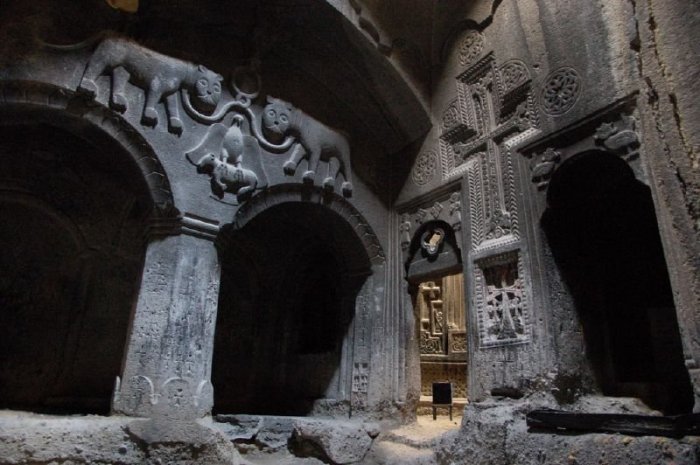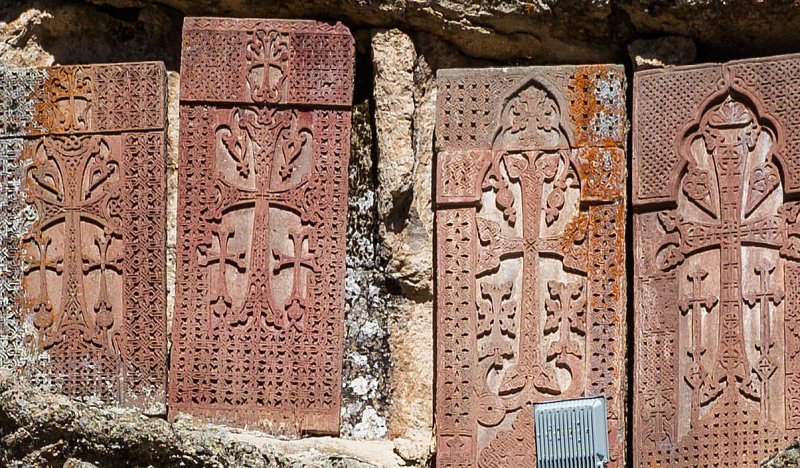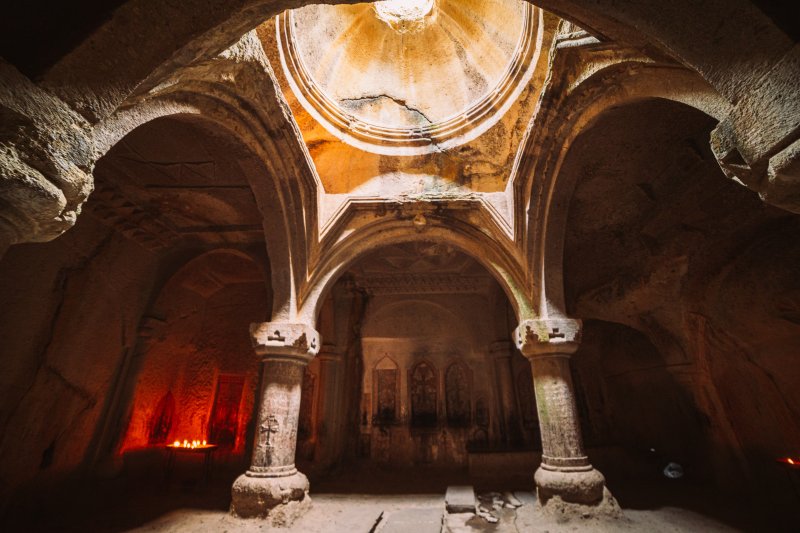Fascinating Geghard Monastery: Rock-Cut Secret Caves, Passages And Hundreds Of Monk Cells
A. Sutherland - AncientPages.com - The history of Geghard and traditions that date back to pre-Christian times, Armenians were influenced by the Persians and their Zoroastrian religion.
Initially, the monument was known as Ayrivank, and after the 13th century, it became known under the name of Geghard (in Armenian: "spear" or "lance"). This name is related to the Holy Spear, which was stored there.
Jamatun/first rock-cut chamber. Image credit: c a r a m e l - CC BY-SA 2.0
The Geghard Monastery, located in the valley of the river Azat 30 kilometers East of Yerevan, has been a sanctuary for pilgrims over many centuries and one of Armenia's most influential spiritual centers. The Church dedicated to the Holy Virgin Mary is the oldest hewn-in-the-rock monument in the Geghard Complex.
However, the place was used not only for religious celebrations and worship but also as a gathering place for discussing the country's political, national, and social issues.
Tradition has it that the Monastery was founded by Saint Gregory the Illuminator (303 – 325). In the 4th century, it was the summer residence of St. Nerses the Great (353 – 373).
The Monastery, partly carved out of the cliff rocks, is surrounded by massive high walls on three sides and the mountain on the fourth. Inside are many interconnected chapels and a maze of caves, secret rooms, tombs, and khachkars (cross-stones) - outdoor steles carved from stone- constitute an authentic Armenian art form.
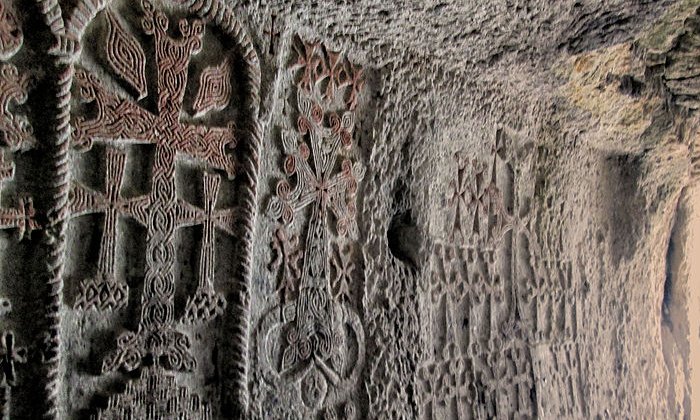 Geghard Monastery - Armenia. Image credit: Beko - CC BY-SA 4.0
Geghard Monastery - Armenia. Image credit: Beko - CC BY-SA 4.0
The main cathedral of the cross-dome type was built in 1215, but legend has it that Geghard Monastery was founded in the 4th century. The first Monastery at this site was called Ayrivank ('Cave monastery' or the 'Monastery of the Caves') but was burned down and plundered in 923.
On the rock cliff walls near the cells and above the Church, there are intricately carved khachkars (stone crosses), and the carvings date to the early medieval period, but most are from the 11th-13th centuries, with a few from later periods.
According to legend, the apostle Thaddeus brought a spear to the Geghard Monastery, the same spear that had wounded Christ on the Cross.
In 1240, Armenian prince Prosh bought the Monastery and conducted a series of unique construction works along with the underground part carved out of rock.
Geghard Monastery- Khachkars inset in the rock outcropping. Image credit: Diego Delso - CC BY-SA 4.0
The earliest surviving part of the Monastery, the Chapel of the Mother of God, dates from before 1164. This chapel is partly connected with passages and small rooms, fully carved into the rock.
There are more than 20 other rock-hewn chapels and service premises, many of which have carvings depicting various animals, birds, and flowers and beautiful geometrical and floral patterns.
The southern facade has an attractive decoration in the form of prince Prosh's coat of arms (lion attacking an ox) of the family of the Zakarian prince who built it. The lion symbolizes royal might.
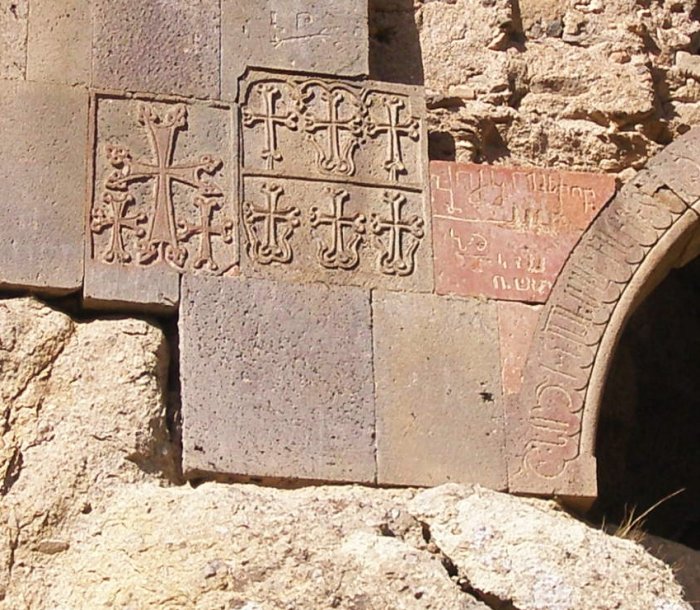 Arched entrance to the caves adjacent to the monastery. Liveon001 - CC BY-SA 3.0
Arched entrance to the caves adjacent to the monastery. Liveon001 - CC BY-SA 3.0
To the right of the mausoleum's entrance, there are carved two sirens, mythical creatures with the crowned head of a woman and the body of a bird.
These creatures lived on rocky islets off the coast of Sicily and lured men to their death. They either enchanted them with their singing so they were shipwrecked on the rocks or, in some versions, lulled the men to sleep with their singing so that the sirens could murder them while they slept.
The Geghard Monastery complex contains numerous, perhaps even hundreds of monk cells carved in the surrounding cliffs. The Monastery had an ascetic tradition, and monks, originally hermits, lived, worked, and prayed in the cells. Many of them did not leave their small quarters until they died.
Geghard Monastery inside. Credit: Adobe Stock - Dmitriy Kandinskiy
The acoustics of the Monastery's chambers is impressive. One of the churches has been designed with acoustics producing a remarkable and mysterious sound, almost like a divine echo. The acoustics allowed the rooms to ideally amplify monks' chants when the Monastery was in use.
Monastic cells and several small churches were cut out of the surrounding volcanic tuff.
They represent an 11th-century feat of engineering and architecture of the Armenian masters.
Written by – A. Sutherland - AncientPages.com Senior Staff Writer
Updated on October 11, 2022
Copyright © AncientPages.com All rights reserved. This material may not be published, broadcast, rewritten or redistributed in whole or part without the express written permission of AncientPages.com
Expand for referencesMore From Ancient Pages
-
 Solstices Brought Mayan Communities Together, Using Monuments Shaped By Science And Religion – And Kingly Ambitions, Too
Featured Stories | Jul 6, 2024
Solstices Brought Mayan Communities Together, Using Monuments Shaped By Science And Religion – And Kingly Ambitions, Too
Featured Stories | Jul 6, 2024 -
 What Does The Brain Of The Homo Erectus Fossil With The Lowest Cranial Capacity Tell About Evolution?
Archaeology | Mar 2, 2023
What Does The Brain Of The Homo Erectus Fossil With The Lowest Cranial Capacity Tell About Evolution?
Archaeology | Mar 2, 2023 -
 ‘Umeda Graves’ Dated To Edo Period Discovered At Osaka, Japan
Archaeology | Aug 21, 2020
‘Umeda Graves’ Dated To Edo Period Discovered At Osaka, Japan
Archaeology | Aug 21, 2020 -
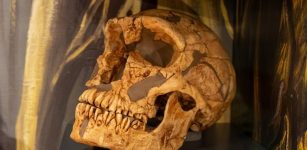 Why Is La Ferrassie Man A Unique And Famous Neanderthal?
Featured Stories | Oct 30, 2023
Why Is La Ferrassie Man A Unique And Famous Neanderthal?
Featured Stories | Oct 30, 2023 -
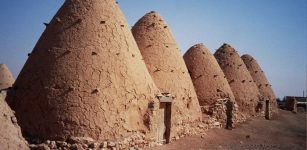 Beehive’ Adobe Houses Of Ancient City Of Harran, Upper Mesopotamia
Civilizations | Dec 28, 2018
Beehive’ Adobe Houses Of Ancient City Of Harran, Upper Mesopotamia
Civilizations | Dec 28, 2018 -
 Extraordinary Gold Pendant With Cross Re-Writes Anglo-Saxon History – It’s One Of The Oldest Symbols Of Christianity Ever Found In East Anglia
Archaeology | Dec 11, 2017
Extraordinary Gold Pendant With Cross Re-Writes Anglo-Saxon History – It’s One Of The Oldest Symbols Of Christianity Ever Found In East Anglia
Archaeology | Dec 11, 2017 -
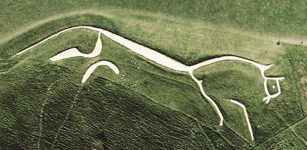 Mystery Of Prehistoric Gigantic Hill Figures Of England
Featured Stories | Sep 20, 2018
Mystery Of Prehistoric Gigantic Hill Figures Of England
Featured Stories | Sep 20, 2018 -
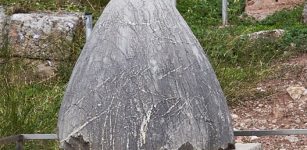 Omphalos – Mysterious Ancient Sacred Object And Its Meaning
Artifacts | May 24, 2017
Omphalos – Mysterious Ancient Sacred Object And Its Meaning
Artifacts | May 24, 2017 -
 William Adams: The Journey To Becoming The First White Samurai
Featured Stories | Jul 11, 2018
William Adams: The Journey To Becoming The First White Samurai
Featured Stories | Jul 11, 2018 -
 Ancient Symbol Fleur-de-lis: It’s Meaning And History Explained
Ancient Symbols | May 19, 2020
Ancient Symbol Fleur-de-lis: It’s Meaning And History Explained
Ancient Symbols | May 19, 2020 -
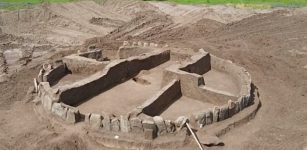 Ancient Secrets Of The Ukrainian Stonehenge That Is Older Than The Giza Pyramids Of Egypt
Featured Stories | Jul 17, 2021
Ancient Secrets Of The Ukrainian Stonehenge That Is Older Than The Giza Pyramids Of Egypt
Featured Stories | Jul 17, 2021 -
 A Glimpse Into The Past – Sights And Sounds Of St. Paul’s Cathedral Recreated
Archaeology | Oct 8, 2021
A Glimpse Into The Past – Sights And Sounds Of St. Paul’s Cathedral Recreated
Archaeology | Oct 8, 2021 -
 Ancient Mysteries Of Wisconsin – Great Forgotten Prehistoric Events Shed New Light On History Of North America
Ancient Mysteries | Jan 11, 2019
Ancient Mysteries Of Wisconsin – Great Forgotten Prehistoric Events Shed New Light On History Of North America
Ancient Mysteries | Jan 11, 2019 -
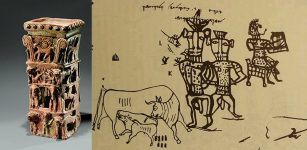 Ancient ‘Yahweh And His Asherah’ Inscriptions At Kuntillet ‘Ajrud Remain An Unsolved Biblical Mystery
Biblical Mysteries | Feb 12, 2021
Ancient ‘Yahweh And His Asherah’ Inscriptions At Kuntillet ‘Ajrud Remain An Unsolved Biblical Mystery
Biblical Mysteries | Feb 12, 2021 -
 On This Day In History: Sir Francis Drake Sets Sail On His Round-The-World Voyage – On Dec 13, 1577
News | Dec 13, 2016
On This Day In History: Sir Francis Drake Sets Sail On His Round-The-World Voyage – On Dec 13, 1577
News | Dec 13, 2016 -
 Long-Lost Anglo-Saxon Monastery Ruled By Queen Cynethryth Of Mercia Discovered By Archaeologists
Archaeology | Aug 19, 2021
Long-Lost Anglo-Saxon Monastery Ruled By Queen Cynethryth Of Mercia Discovered By Archaeologists
Archaeology | Aug 19, 2021 -
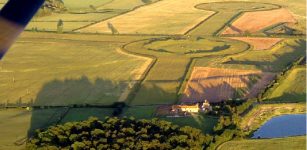 Future Of Thornborough Henges Secured – Stonehenge Of The North Preserved For The Nation
News | Feb 3, 2023
Future Of Thornborough Henges Secured – Stonehenge Of The North Preserved For The Nation
News | Feb 3, 2023 -
 Vast Network Of Previously Unknown European Bronze Age Megastructures Discovered
Archaeology | Nov 20, 2023
Vast Network Of Previously Unknown European Bronze Age Megastructures Discovered
Archaeology | Nov 20, 2023 -
 Enigmatic Footprints Reveal Humans Were In Spain 200,000 Years Earlier Than Previously Thought
Archaeology | Nov 11, 2022
Enigmatic Footprints Reveal Humans Were In Spain 200,000 Years Earlier Than Previously Thought
Archaeology | Nov 11, 2022 -
 3,300-Year-Old Hittite Cuneiform Tablet Found In Büklükale Deciphered!
Archaeology | Apr 2, 2024
3,300-Year-Old Hittite Cuneiform Tablet Found In Büklükale Deciphered!
Archaeology | Apr 2, 2024

